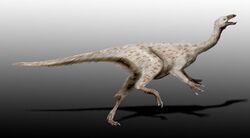Earth:Xinminbao Group
| Xīnmínbǎo Group 新民堡群 Stratigraphic range: Late Barremian-Aptian | |
|---|---|
| Type | Geological formation |
| Sub-units | Chijinbao Formation, Digou Formation, Xiagou Formation, Zhonggou Formation |
| Lithology | |
| Primary | Conglomerate, siltstone, mudstone |
| Other | Sandstone |
| Location | |
| Region | East Asia |
| Country | |
The Xīnmínbǎo Group (Chinese: 新民堡群; pinyin: Xīnmínbǎo qún) is a group of geological formations in north central China . They occur across a large depression between the Altai mountains of Mongolia to the north and the Qilian mountains of the Qinghai Plateau to the south, in the Gōngpóquán (公婆泉) and Suànjǐngzi (算井子) basins, and also in the neighbouring Jiuquan Basin.
Both of these areas are inland basins consisting of fluvial (river), lacustrine (lake), and intermontane (between mountains) alluvial fan (floodplain) sediments that were deposited during the Early Cretaceous, probably during the Aptian or possibly late Barremian stage, when the climate was semi-arid and subtropical.
The group has been visited by many expeditions including the Silk Road dinosaur expedition of 1992 which concentrated on the area around Mazong Shan.
Geology
The group is made up of three main formations.[citation needed]
Chijinbao Formation
This consists of a lower red unit of coarse conglomerates grading to fine sandstones representing river channel to alluvial fan deposits, and an upper unit of red clastic sediments from either overbank deposits in a meandering fluvial environment, or accumulation in a shallow lacustrine or paludal (marsh) environment.[citation needed]
Digou Formation
This consists of grey siltstones and calcareous mudstones comprising two sequences of fluvio-lacustrine sedimentation with some alluvial fan and littoral (lake-shore) deposits.[citation needed]
Zhonggou Formation
This consists of red siltstones and mudstones in a series of upwardly coarsening cycles of lacustrine sediments.[citation needed]
Vertebrate fauna
Ceratopsians
| Ceratopsians reported from the Xinminbao Group | ||||||
|---|---|---|---|---|---|---|
| Genus | Species | Location | Stratigraphic position | Material | Notes | Images |
|
Archaeoceratops oshimai |
"[Two] individuals lacking forelimbs."[1] |
  | ||||
|
Auroraceratops rugosus |
||||||
|
Microceratus gobiensis |
||||||
|
Microceratus sulcidens |
||||||
|
Psittacosaurus mazongshanensis |
"One individual lacking caudal and hindlimb."[1] |
|||||
Crocodilians
Indeterminate crocodilian remains are known from the group.
| Crocodilians reported from the Xinminbao Group | ||||||
|---|---|---|---|---|---|---|
| Genus | Species | Location | Stratigraphic position | Material | Notes | Images |
|
Chiayusuchus |
Chiayusuchus cingulatus |
|||||
Fish
| Ray-finned fishes reported from the Xinminbao Group | ||||||
|---|---|---|---|---|---|---|
| Genus | Species | Location | Stratigraphic position | Material | Notes | Images |
|
Xixiaichthys tongxinensis |
||||||
Ornithopods
| Ornithopods reported from the Xinminbao Group | ||||||
|---|---|---|---|---|---|---|
| Genus | Species | Location | Stratigraphic position | Material | Notes | Images |
|
Equijubus normani |
"Skull and partial postcranial skeleton."[2] |
(both this and Probactrosaurus are properly hadrosauroids rather than hadrosaurids) | ||||
|
Gongpoquansaurus mazongshanensis |
"Partial skull and postcranial skeleton."[4] |
|||||
|
Siluosaurus zhangqiani |
"Teeth."[5] |
Nomen dubium, tentatively classified as a Hypsilophodontid. | ||||
Pterosaurs
| Pterosaurs reported from the Xinminbao Group | ||||||
|---|---|---|---|---|---|---|
| Genus | Species | Location | Stratigraphic position | Material | Notes | Images |
|
Noripterus |
Indeterminate |
 | ||||
Saurischians
| Saurischians reported from the Xinminbao Group | ||||||
|---|---|---|---|---|---|---|
| Genus | Species | Location | Stratigraphic position | Material | Notes | Images |
|
Asiatosaurus mongoliensis |
  | |||||
|
Beishanlong grandis |
A deinocheirid ornithomimosaur. | |||||
|
C. lacustris |
||||||
|
Gobititan shenzhouensis |
||||||
|
"Nanshiungosaurus" |
"Nanshiungosaurus bohlini" |
This species does not belong to Nanshiungosaurus.[7][8] | ||||
|
Indeterminate |
||||||
Thyreophorans
Indeterminate ankylosaur remains are known from the group.
| Thyreophorans of the Xinminbao Group | ||||||
|---|---|---|---|---|---|---|
| Genus | Species | Location | Stratigraphic position | Abundance | Notes | |
|
Stegosaurides excavatus |
(nomen dubium) | |||||
Turtles
| Turtles of the Xinminbao Group | ||||||
|---|---|---|---|---|---|---|
| Genus | Species | Location | Stratigraphic position | Abundance | Notes | |
|
Tsaotanemys |
Tsaotanemys rugosus |
|||||
See also
- List of dinosaur-bearing rock formations
References
- ↑ 1.0 1.1 "Table 22.1," in Weishampel, et al. (2004). Page 479.
- ↑ "Table 19.1," in Weishampel, et al. (2004). Page 415.
- ↑ H.-l. You et al. (in press). "Gongpoquansaurus mazongshanensis (Lü, 1997) comb. nov. (Ornithischia: Hadrosauroidea) from the Early Cretaceous of Gansu Province, northwestern China". In David A. Eberth and David C. Evans (eds). Hadrosaurs: Proceedings of the International Hadrosaur Symposium. Indiana University Press. ISBN:978-0-253-01385-9. Check date values in: |date= (help)
- ↑ "Table 19.1," in Weishampel, et al. (2004). Page 417.
- ↑ "Table 18.1," in Weishampel, et al. (2004). Page 396.
- ↑ Dong, Z.; You, H. (1997). "A new segnosaur from Mazhongshan Area, Gansu Province, China". Sino-Japanese Silk Road Dinosaur Expedition. Beijing: China Ocean Press. pp. 90−95.
- ↑ 7.0 7.1 Zanno, L. E. (2010). "A taxonomic and phylogenetic re-evaluation of Therizinosauria (Dinosauria: Maniraptora)". Journal of Systematic Palaeontology 8 (4): 503−543. doi:10.1080/14772019.2010.488045. https://www.researchgate.net/publication/229289268.
- ↑ You, H.; Morschhauser, E. M.; Li, D.; Dodson, P. (2018). "Introducing the Mazongshan Dinosaur Fauna". Journal of Vertebrate Paleontology 38 (sup. 1): 1−11. doi:10.1080/02724634.2017.1396995.
Further reading
- A new Psittacosaur (Psittacosaurus mazongshanensis sp. nov.) from Mazongshan area, Ganzu Province. Xu, X. Sino-Japanese Silk Road dinosaur expedition., Dong, Z. (ed). China Ocean press; 48-67 (1997).
- Biostratigraphy and palaeoenvironment of the dinosaur-bearing sediments in Lower Cretaceous of Mazongshan area, Gansu Province, China. Tang, F., Luo, Z., Zhou, Z., You, H., Georgi, J., Tang, Z., and Wang. X. Cretaceous Research 22, 115-129 (2001).
 |

